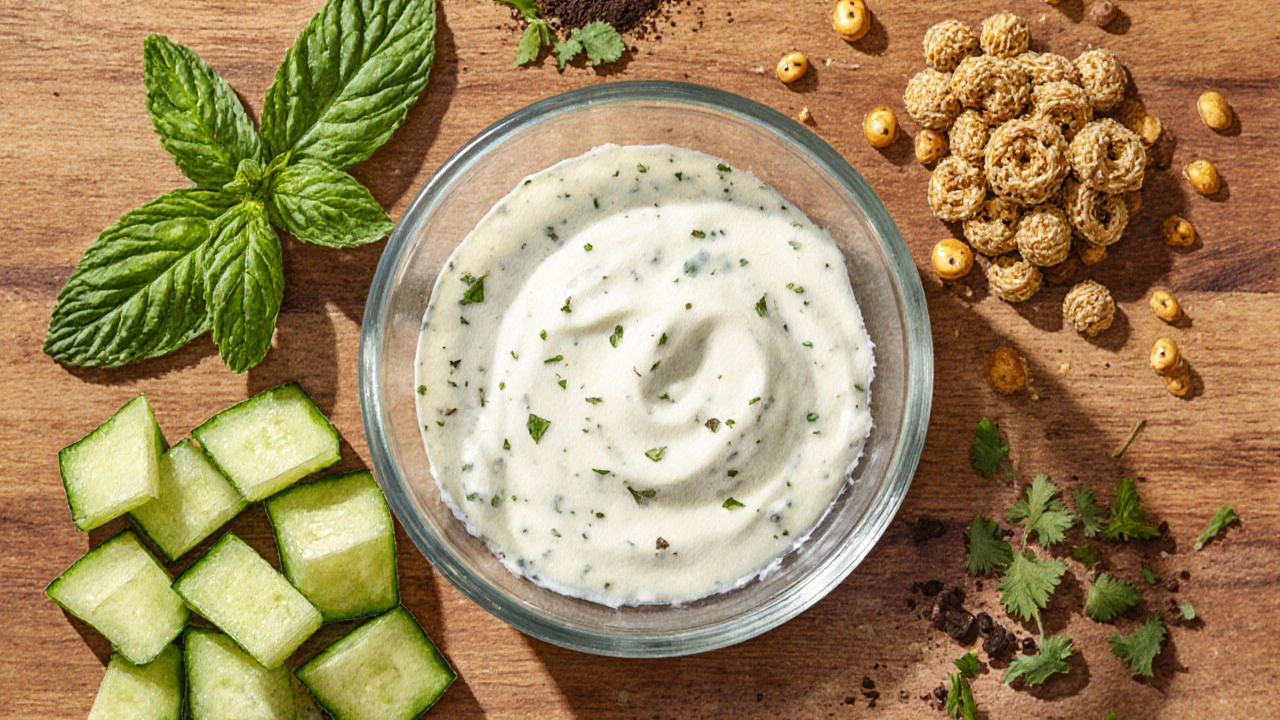When you spot a bowl of creamy white liquid on the side of a steaming plate of biryani, you’re probably looking at biryani raita. It’s the cool, tangy partner that balances the spices, cuts the heat, and adds a silky texture to every bite. Below we’ll break down what raita actually is, why it belongs with biryani, and how to whip up the most popular versions in your kitchen.
Understanding Raita: The White Liquid Explained
Raita is a yogurt‑based condiment commonly found in Indian and South Asian meals. It typically mixes plain Yogurt with diced vegetables, herbs, and a pinch of spices. The result is a smooth, slightly tangy sauce that can be as simple as plain curd or as elaborate as a boondi‑laden masterpiece.
Raita isn’t a side dish you’re forced to serve; it’s a tradition that grew out of necessity. The hot, aromatic rice dish of biryani can be quite intense, especially when chilies and garam masala are in full swing. A spoonful of cool yogurt softens the heat and makes the whole meal more approachable.
Why Raita Is the Perfect Biryani Companion
Here are the key reasons raita earns a permanent spot on the biryani table:
- Temperature balance: The chilled yogurt tempers the steaming heat of the rice and meat.
- Flavor contrast: Tanginess from the yogurt highlights the sweet notes of saffron and raisins often used in biryani.
- Digestive aid: Probiotic‑rich yogurt helps break down the heavy spices, easing digestion.
- Visual appeal: The white splash against golden biryani creates a striking plate presentation.
Because of these benefits, most restaurants and home cooks never serve biryani without a side of raita.
Core Ingredients and Their Roles
Every raita starts with a base of Yogurt. Choose full‑fat plain yogurt for richness; low‑fat versions can feel thin and won’t coat the palate as well. The other ingredients fall into three groups: vegetables, herbs, and spices.
| Component | Typical Example | Purpose |
|---|---|---|
| Vegetable | Cucumber, onion, tomato | Add crunch and freshness |
| Herb | Mint, cilantro (coriander) | Introduce aromatic coolness |
| Spice | Roasted Cumin, black pepper, Garam masala | Boost depth without heat |
| Optional Add‑in | Boondi (fried chickpea droplets) | Give texture and visual interest |

Three Must‑Try Raita Variations for Biryani
While the classic cucumber raita is a safe bet, here are three crowd‑pleasers you can rotate throughout the week.
1. Cucumber‑Mint Raita (the go‑to)
Ingredients:
- 1 cup plain Yogurt (full‑fat, unsweetened)
- ½ cup finely diced Cucumber (seeds removed)
- 1 tbsp chopped Mint leaves
- ¼ tsp roasted Cumin powder
- Pinch of salt and a dash of black pepper
Method:
- Whisk the yogurt until smooth.
- Stir in cucumber, mint, and cumin.
- Season with salt and pepper; chill for 15 minutes before serving.
This version delivers a crisp bite and a refreshing aroma that pairs perfectly with chicken or lamb biryani.
2. Boondi Raita (textured delight)
Ingredients:
- 1 cup plain Yogurt
- ¼ cup puffed Boondi (store‑bought or homemade)
- 2 tbsp chopped Cilantro (coriander leaves)
- ½ tsp roasted Cumin powder
- Red chili powder (optional, for a hint of heat)
- Salt to taste
Method:
- Mix yogurt, cumin, and salt until uniform.
- Add boondi and let it sit for 5 minutes; the droplets soften slightly.
- Garnish with cilantro and a light sprinkle of chili powder.
Boondi gives each bite a subtle crunch, making the raita feel more substantial alongside fragrant rice.
3. Onion‑Coriander Raita (sharp & herbaceous)
Ingredients:
- 1 cup plain Yogurt
- ¼ cup finely chopped red onion
- 2 tbsp chopped Cilantro
- ¼ tsp roasted Cumin powder
- Pinch of black pepper
- Salt to taste
Method:
- Whisk yogurt until creamy.
- Stir in onion, cilantro, and cumin.
- Season with pepper and salt, then chill.
The onion’s bite lifts the richness of biryani, while cilantro adds a bright, citrusy note.
Tips for Perfect Raita Every Time
- Use fresh yogurt: It should be slightly thick; if it’s runny, strain it through cheesecloth for 20 minutes.
- Season after mixing: Salt draws out moisture from veggies; add it at the end to keep the raita smooth.
- Chill before serving: A cold raita accentuates the contrast with hot biryani.
- Adjust consistency: For a thinner dip, whisk in a splash of milk or buttermilk; for a dipper, keep it thick.
- Don’t over‑spice: Raita’s role is subtle; keep spices light so they don’t overpower the yogurt.
Common Mistakes and How to Fix Them
Raita turns watery. This usually happens when salty veggies release water. Pat them dry with paper towels before adding to yogurt.
It tastes bland. Add a squeeze of lemon juice or a pinch of chaat masala for a flavor boost.
Too sour. Balance with a pinch of sugar or a drizzle of honey; the sweetness tones down excess tang.

Serving Raita with Different Types of Biryani
Whether you’re serving Hyderabad’s spicy chicken biryani, Kolkata’s fragrant egg biryani, or a milder vegetarian pumpkin biryani, raita can be tweaked:
- Spicy biryani: Opt for plain yogurt or cucumber‑mint raita to cool the heat.
- Rich, meat‑laden biryani: Boondi raita adds texture that complements the heft of meat.
- Vegetarian biryani: Onion‑coriander raita offers a sharp contrast to sweet vegetables.
Adjust the herb mix (mint for heat, cilantro for freshness) according to the biryani’s flavor profile.
Frequently Asked Questions
Can I use Greek yogurt instead of regular yogurt?
Yes. Greek yogurt is thicker and creamier, which makes a richer raita. If you find it too dense, thin it with a little water or milk.
Is raita suitable for vegans?
Traditional raita relies on dairy yogurt, so it isn’t vegan. However, you can substitute coconut‑based yogurt or soy yogurt and keep the same spices and veggies.
How long can I store homemade raita?
Store it in an airtight container in the fridge for up to 3 days. Stir before serving; separation is normal.
Why does my raita get a sour smell after a day?
If the yogurt wasn’t fresh or the container wasn’t sealed, bacteria can develop. Use fresh yogurt and keep the lid tight.
Can I add fruit to raita?
Yes-pomegranate seeds, diced mango, or pineapple add a sweet‑tart twist that works well with milder biryanis.
Next Steps: Your Raita Routine
Pick one of the three recipes above and try it alongside your favorite biryani this week. Notice how the flavors change when the raita is cooler or room‑temperature. Tweak the herbs-swap mint for dill or add a pinch of roasted fenugreek leaves for something new.
Once you’re comfortable, experiment with mixed‑fruit raitas for special occasions or serve boondi raita at family gatherings for a crunchy surprise.
Remember, the white liquid isn’t just a garnish; it’s a functional, tasty bridge that brings together the complex layers of biryani into a harmonious bite.
